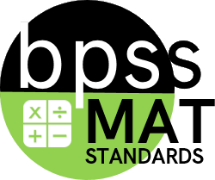BPS District Mathematics Standards Book
K-8 Grade Levels
Grade 06
Sixth Grade Math
"I can ... statements"
 The skills and understanding that your child will gain during 6th grade are among the most important foundations for college and career readiness. These include working with ratios and rates and working with variables and variable expressions
— the building blocks of algebra. Many of this year’s topics will remain a major emphasis throughout the middle school years and into high school.
The skills and understanding that your child will gain during 6th grade are among the most important foundations for college and career readiness. These include working with ratios and rates and working with variables and variable expressions
— the building blocks of algebra. Many of this year’s topics will remain a major emphasis throughout the middle school years and into high school.
MAT-06.RP Domain:
[RP] Ratios and Proportional Relationships
- MAT-06.RP.01 Understand the concept of a ratio and use ratio language to describe a ratio relationship between two quantities.
- MAT-06.RP.02 Understand the concept of a unit rate a/b associated with a ratio a:b with b ≠ 0, and use rate language in the context of a ratio relationship.
- MAT-06.RP.03 Use tables of equivalent ratios, tape diagrams, double number line diagrams, and equations to reason about ratios and rates in real world and mathematical problems.
- MAT-06.RP.03.abd Make tables of equivalent ratios, unit rate, measurement conversion.
- MAT-06.RP.03.c Find a percent of a quantity as a rate per 100. Solve problems involving finding the whole, given a part and the percent.
MAT-06.NS Domain:
- MAT-06.NS.01 Use visual fraction models and equations to interpret and compute quotients of fractions. Use models and equations to solve word problems involving division of fractions by fractions.
- MAT-06.NS.02 Fluently divide multi-digit numbers using strategies flexibly, including the standard algorithm.
- MAT-06.NS.03 Fluently add, subtract, multiply, and divide multi-digit decimals using strategies flexibly, including the standard algorithm for each operation.
- MAT-06.NS.04 Find the greatest common factor of two whole numbers less than or equal to 100 and the least common multiple of two whole numbers less than or equal to 12. Use the distributive property to express a sum of two whole numbers 1 to 100 with a common factor as a multiple of a sum of two whole numbers with no common factor.
- MAT-06.NS.05 Understand that rational numbers are used together to describe quantities having opposite directions or values. Use rational numbers to represent quantities in real world contexts, explaining the meaning of 0 in each situation.
- MAT-06.NS.06 Understand a rational number as a point on the number line. Extend number line diagrams and coordinate axes from previous grades to represent points on the line and in the plane with negative number coordinates.
- MAT-06.NS.06.a Recognize opposite signs of numbers as indicating locations on opposite sides of 0 on the number line. Recognize that the opposite of the opposite of a number is the number itself, for example: -(-3)=3, and that 0 is its own opposite.
- MAT-06.NS.06.b Understand signs of numbers in ordered pairs as indicating locations in quadrants of the coordinate plane. Recognize that when two ordered pairs differ only by signs, the locations of the points are related by reflections across one or both axes.
- MAT-06.NS.06.c Find and position integers and other rational numbers on a horizontal or vertical number line diagram. Find and position pairs of integers and other rational numbers on a coordinate plane.
- MAT-06.NS.07 Understand ordering and absolute value of rational numbers.
- MAT-06.NS.07.a Interpret statements of inequality as statements about the relative position of two numbers on a number line diagram
- MAT-06.NS.07.b Write, interpret, and explain statements of order for rational numbers in real world contexts
- MAT-06.NS.07.c Understand the absolute value of a rational number as its distance from 0 on the number line. Interpret absolute value as magnitude for a positive or negative quantity in a real world situation
- MAT-06.NS.07.d Distinguish comparisons of absolute value from statements about order.
- MAT-06.NS.08 Solve real world and mathematical problems by graphing points in all four quadrants of the coordinate plane. Include Use of coordinates and absolute value to Find distances between points with the same first coordinate or the same second coordinate.
MAT-06.EE Domain:
[EE] Expressions and Equations
- MAT-06.EE.01 Write and evaluate numerical expressions involving whole-number exponents
- MAT-06.EE.02 Write, Read, and evaluate expressions in which letters stand for numbers.
- MAT-06.EE.02.a Write expressions that record operations with numbers and with letters standing for numbers.
- MAT-06.EE.02.b Identify parts of an expression using mathematical terms (sum, term, product, factor, quotient, coefficient, difference, quantity, etc.); view one or more parts of an expression as a single entity.
- MAT-06.EE.02.c Evaluate expressions at specific values of their variables. Include expressions that arise from formulas used in real world problems. Perform arithmetic operations, including those involving whole-number exponents, in the conventional order when there are no parentheses to specify a particular order (Order of Operations).
- MAT-06.EE.03 Apply the properties of operations to generate equivalent expressions.
- MAT-06.EE.04 Identify when two expressions are equivalent.
- MAT-06.EE.05 Understand solving an equation or inequality as a process of answering a question: Which values from a specified set, if any, make the equation or inequality true? Use substitution to determine whether a given number in a specified set makes an equation or inequality true.
- MAT-06.EE.06 Use variables to represent numbers and write expressions when solving a real world or mathematical problem. Understand that a variable can represent an unknown number, or, depending on the purpose at hand, any number in a specified set.
- MAT-06.EE.07 Solve real world and mathematical problems by writing and solving equations of the form x + p = q and px = q for cases in which p, q and x are all nonnegative rational numbers.
- MAT-06.EE.08 Write a statement of inequality of the form x > c or the form x < c to represent a constraint or condition in a real world or mathematical problem. Recognize that inequalities of the form x > c or the form x < c have infinitely many solutions; represent solutions of such inequalities on number line diagrams.
- MAT-06.EE.09 Use variables to represent two quantities in a real world problem that change in relationship to one another. Write an equation to express one quantity (dependent variable) in terms of the other quantity (independent variable). Analyze the relationship
MAT-06.G Domain:
- MAT-06.G.01 Based on prior knowledge of area of rectangles, decompose or Compose triangles to Find the area of a triangle. using knowledge of area of triangles and rectangles, Compose and/or decompose triangles, special quadrilaterals, and polygons to Find their areas. Apply these techniques in the context of solving real world mathematical problems.
- MAT-06.G.02 Using cubes of an appropriate size, pack a right rectangular prism having fractional edge lengths to find its volume. Then show that the volume is the same as would be found by multiplying the edge lengths of the prism. Apply the formulas V = ℓwh and V = Bh to find volumes of right rectangular prisms with fractional edge lengths in the context of solving real world and mathematical problems.
- MAT-06.G.03 Draw polygons in the coordinate plane given coordinates for the vertices. Use coordinates to find the length of a side joining points with the same first coordinate or the same second coordinate. Apply these techniques in the context of solving real world and mathematical problems.
- MAT-06.G.04 Represent three-dimensional figures using nets made up of rectangles and triangles (right prisms and pyramids whose bases are triangles and rectangles). Use the nets to find the surface area of these figures. Apply these techniques in the context of solving real world and mathematical problems.
MAT-06.SP Domain:
[SP] Statistics and Probability
- MAT-06.SP.01 Recognize a statistical question as one that anticipates variability in the data related to the question and accounts for it in the answers.
- MAT-06.SP.02 Understand that a set of data collected to answer a statistical question has a distribution which can be described by its center, spread, and overall shape.
- MAT-06.SP.03 Recognize that a measure of center for a numerical data set summarizes all of its values using a single number, while a measure of spread (variation) describes how its values vary with a single number.
- MAT-06.SP.04 Display numerical data in plots on a number line, including dot plots, histograms, and box plots.
- MAT-06.SP.05 Summarize numerical data sets in relation to their context by:
- MAT-06.SP.05.a Reporting the number of observations.
- MAT-06.SP.05.b Describing the nature of the attribute being investigated, including how it was measured and its units of measurement.
- MAT-06.SP.05.c Calculating quantitative measures of center (median and/or mean) and variability (interquartile range and/or mean absolute deviation), as well as describing any overall pattern and any striking deviations from the overall pattern with reference to the context in which the data was gathered.
- MAT-06.SP.05.d Relating the choice of measures of center and variability to the shape of the data distribution and the context in which the data were gathered.
A Sample of What Your Child Will Be Working on in Grade 06
- Understanding ratios and rates, and solving problems involving proportional relationships (e.g., if it took 7 hours to mow 4 lawns, then at that rate, how many lawns could be mowed in 35 hours? At what rate were lawns being mowed?)
- Dividing fractions and solving related word problems (e.g., how wide is a rectangular strip of land with length 3⁄4 mile and area 1⁄2 square mile?)
- Using positive and negative numbers together to describe quantities; understanding the ordering and absolute values of positive and negative numbers
- Working with variables and expressions by generalizing the way numbers work (e.g., when adding numbers, the order doesn’t matter, so x + y = y + x; likewise, properties of addition and multiplication can be used to rewrite 24x + 18y as 6(4x + 3y), or y + y + y as 3y)
- Understanding the process of solving simple equations
- Writing equations to solve word problems and describe relationships between quantities (e.g., the distance D traveled by a train in time T might be expressed by an equation D = 85T, where D is in miles and T is in hours)
- Reasoning about relationships between shapes to determine area, surface area, and volume
